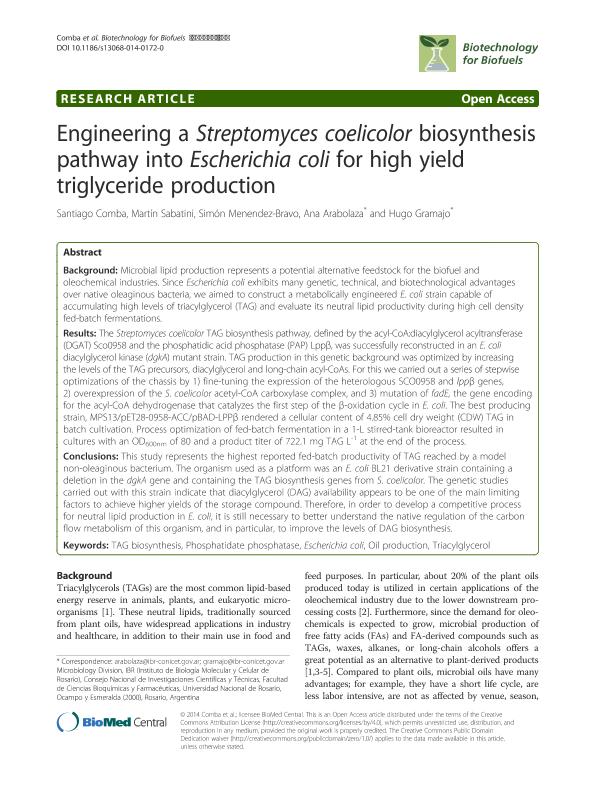Artículo
Engineering a Streptomyces coelicolor biosynthesis pathway into Escherichia coli for high yield triglyceride production
Comba, Santiago ; Sabatini, Martín
; Sabatini, Martín ; Menendez-bravo, Simón Matías
; Menendez-bravo, Simón Matías ; Arabolaza, Ana Lorena
; Arabolaza, Ana Lorena ; Gramajo, Hugo Cesar
; Gramajo, Hugo Cesar
 ; Sabatini, Martín
; Sabatini, Martín ; Menendez-bravo, Simón Matías
; Menendez-bravo, Simón Matías ; Arabolaza, Ana Lorena
; Arabolaza, Ana Lorena ; Gramajo, Hugo Cesar
; Gramajo, Hugo Cesar
Fecha de publicación:
09/2014
Editorial:
BioMed Central
Revista:
Biotechnology For Biofuels
ISSN:
1754-6834
Idioma:
Inglés
Tipo de recurso:
Artículo publicado
Clasificación temática:
Resumen
Background Microbial lipid production represents a potential alternative feedstock for the biofuel and oleochemical industries. Since Escherichia coli exhibits many genetic, technical, and biotechnological advantages over native oleaginous bacteria, we aimed to construct a metabolically engineered E. coli strain capable of accumulating high levels of triacylglycerol (TAG) and evaluate its neutral lipid productivity during high cell density fed-batch fermentations. Results The Streptomyces coelicolor TAG biosynthesis pathway, defined by the acyl-CoA:diacylglycerol acyltransferase (DGAT) Sco0958 and the phosphatidic acid phosphatase (PAP) Lppβ, was successfully reconstructed in an E. coli diacylglycerol kinase (dgkA) mutant strain. TAG production in this genetic background was optimized by increasing the levels of the TAG precursors, diacylglycerol and long-chain acyl-CoAs. For this we carried out a series of stepwise optimizations of the chassis by 1) fine-tuning the expression of the heterologous SCO0958 and lpp β genes, 2) overexpression of the S. coelicolor acetyl-CoA carboxylase complex, and 3) mutation of fadE, the gene encoding for the acyl-CoA dehydrogenase that catalyzes the first step of the β-oxidation cycle in E. coli. The best producing strain, MPS13/pET28-0958-ACC/pBAD-LPPβ rendered a cellular content of 4.85% cell dry weight (CDW) TAG in batch cultivation. Process optimization of fed-batch fermentation in a 1-L stirred-tank bioreactor resulted in cultures with an OD600nm of 80 and a product titer of 722.1 mg TAG L-1 at the end of the process. Conclusions This study represents the highest reported fed-batch productivity of TAG reached by a model non-oleaginous bacterium. The organism used as a platform was an E. coli BL21 derivative strain containing a deletion in the dgkA gene and containing the TAG biosynthesis genes from S. coelicolor. The genetic studies carried out with this strain indicate that diacylglycerol (DAG) availability appears to be one of the main limiting factors to achieve higher yields of the storage compound. Therefore, in order to develop a competitive process for neutral lipid production in E. coli, it is still necessary to better understand the native regulation of the carbon flow metabolism of this organism, and in particular, to improve the levels of DAG biosynthesis
Archivos asociados
Licencia
Identificadores
Colecciones
Articulos(IBR)
Articulos de INST.DE BIOLOGIA MOLECULAR Y CELULAR DE ROSARIO
Articulos de INST.DE BIOLOGIA MOLECULAR Y CELULAR DE ROSARIO
Citación
Comba, Santiago; Sabatini, Martín; Menendez-bravo, Simón Matías; Arabolaza, Ana Lorena; Gramajo, Hugo Cesar; Engineering a Streptomyces coelicolor biosynthesis pathway into Escherichia coli for high yield triglyceride production; BioMed Central; Biotechnology For Biofuels; 7; 9-2014; 172-183
Compartir
Altmétricas



